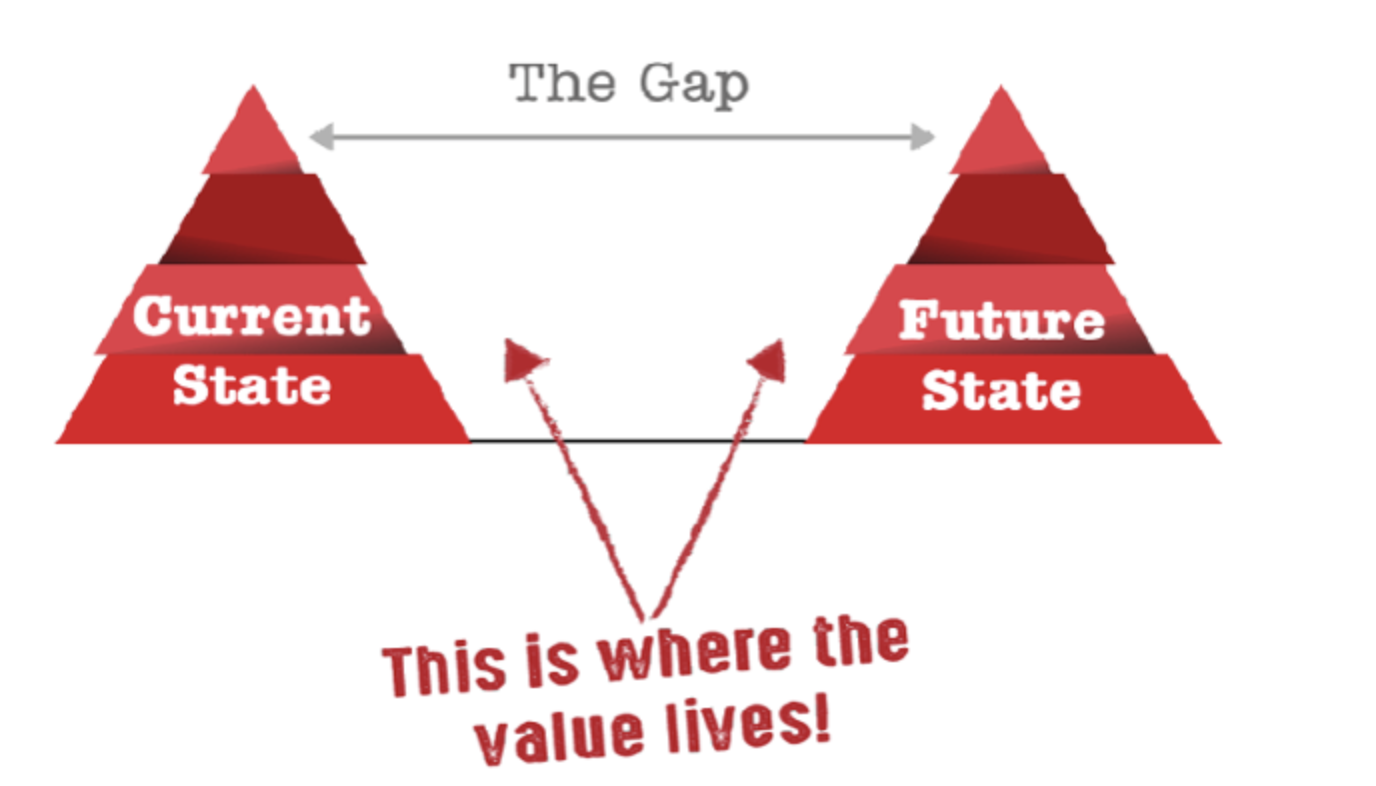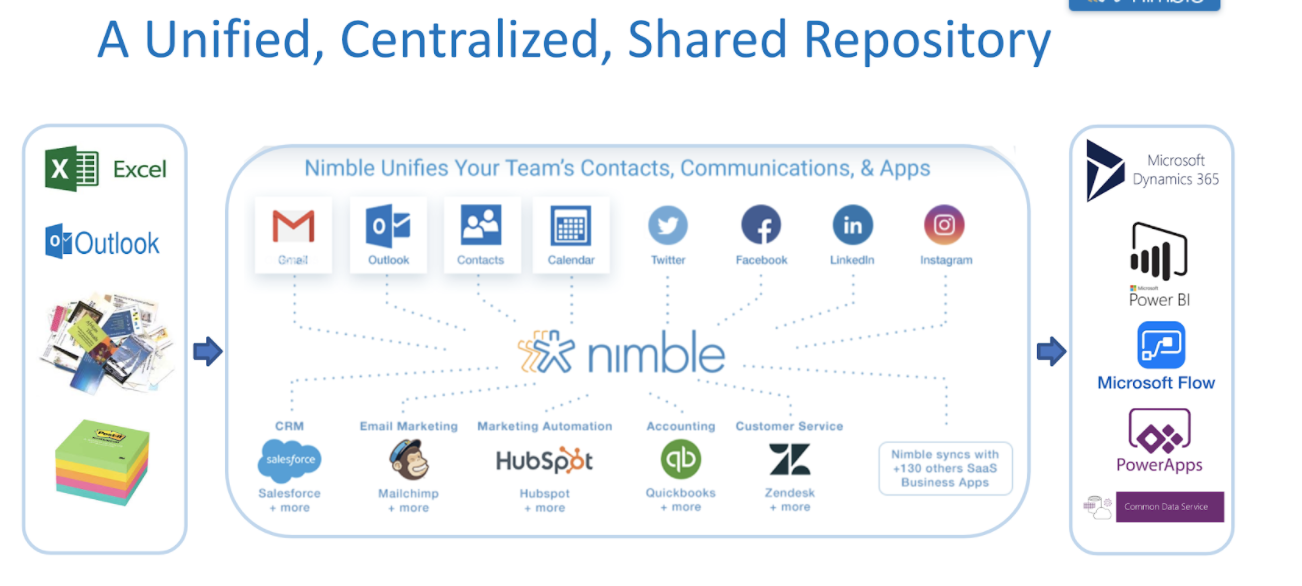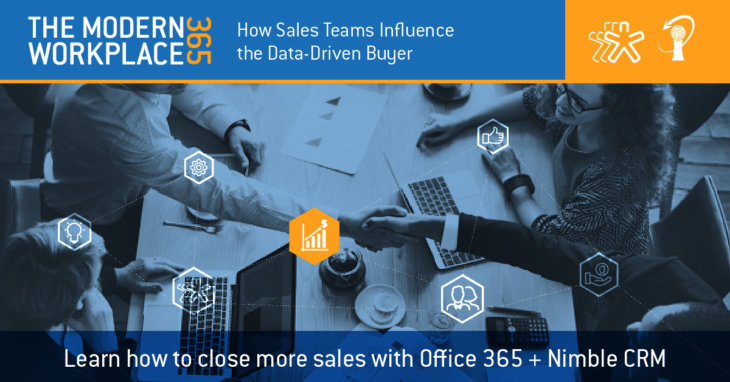The Modern Workplace 365 is a five-part series designed to help small business teams understand the impacts of the data-driven buyer’s journey, the unprecedented rate of technology innovation, and multi-generational work cultures on the Modern Workplace.
In this post, we discuss shifts in customer expectations, changes to the sales mindset, and toolkits that enable sales teams to influence buyers’ digital decision-making journey.
Regardless of the size of your IT budget, the onus is on your business to equip sales teams with constantly connected communications tools, collaborative environments, data, and insights required to inform communications at every point of engagement.
To meet these requirements, small businesses need to implement an integrated set of CRM, sales intelligence, and sales enablement tools running on an IT infrastructure that meets today’s demands for data, insight, and communications. Microsoft works with solution partners like Nimble CRM to deliver a digital infrastructure that meets sales teams’ requirements for high-touch, customer-centric selling.
 “Sometimes when a business is at the very small end — one to seven, one to ten employees — they need to walk and grow, really learning how to use CRM at the beginning level. As they need additional capabilities, (Nimble) is a nice onramp into Dynamics (CRM).”
“Sometimes when a business is at the very small end — one to seven, one to ten employees — they need to walk and grow, really learning how to use CRM at the beginning level. As they need additional capabilities, (Nimble) is a nice onramp into Dynamics (CRM).”
Gretchen O’Hara, Vice President, Go-To-Market Strategy, One Commercial Partner at Microsoft
How data is disrupting the sales process
It’s critical for sales teams to understand that the buyers’ decision-making process has dramatically changed.
Gone are the days when broadcasting accolades about your products or services across the Internet had any real impact on buyers’ behavior. Self-service data has replaced the need for salespeople to educate and direct buyers’ decision-making process.
As sales coach and best selling author Keenan explains:
 “The data available to buyers is now at the core of the buying process — and that data is ubiquitous. Buyers understand what their desired outcomes could be, and what options are available to them, without ever consulting a salesperson.”
“The data available to buyers is now at the core of the buying process — and that data is ubiquitous. Buyers understand what their desired outcomes could be, and what options are available to them, without ever consulting a salesperson.”
— Keenan, CEO and president of sales consulting firm, A Sales Guy, Inc., and author of Gap Selling: Getting the Customer to Yes.
Almost any information regarding a product or service can now be found online anytime. This includes product information, guidance on usage, support, reviews, and competitive comparisons. Nearly as challenging is the noise level of information: Customers are constantly bombarded by competing product messages in their inbox, web pop-ups, search results, and on social media.
According to Keenan, delivering buyer-centric value within the sales process increases the probability of winning the deal:
“Think about the last mile,” explains Keenan. “A person arrives in your hometown. They have a map, and they’ve already decided which state and which town they want to move into, but now they what to know why they should eat at this restaurant versus that one, and why they should live in this neighborhood versus the next one, since everything looks the same.
“They are looking for somebody who understands their current state and their desired future, and can clarify what’s going to help them the most.”
Using Gap Selling to Close More Deals
Properly assessing — and filling — the gap between a buyer’s current state and their desired future state should be what drives the entire sales process.

Source: GAP Selling- Getting the Customer to Yes
“Too many salespeople today spend way too much time in the future state selling its benefits, and not enough time learning about the buyer’s current state,” Keenan explains. “Buyers won’t believe that what you’re selling will get them where they want to go unless you understand their problem.”
When done right, “gap selling” captures the attention of buyers who are inundated by sales pitches from all corners. Ultimately, it can change the nature of the sales/customer relationship. Based on conversation and trust, sales teams can provide clarity to help buyers make informed decisions that are in their favor.
Empowering Teams to Deliver Customer-Centric Value
Your sales team’s ability to deliver customer-centric value is empowered — or, in some cases, limited — by the digital tools that you give them.
Customers and prospects expect everyone they interact with at your company to be in the loop, to know whom they last spoke with, what their questions or concerns were, and what needs to be done next.
Customer-centric selling is the opposite of mass marketing. It is highly personalized, relevant, and specific to that one customer you are working with. However, this approach can be challenging, especially for small businesses with limited IT budgets. As a result, not every company can do it well.
The good news is that there are digital tools available that facilitate the customer-centric sales journey by enabling sales teams to have these kinds of interactions with prospects and buyers. These tools provide valuable sales intelligence, enable collaboration between team members in a secure environment, and suggest next steps (some of which can be automated).
A CRM solution like Nimble, combined with Office 365 and infrastructure technologies from Microsoft, can enable small businesses to deliver these capabilities to your teams in a cost- and resource-effective way.

Nimble provides access to a centralized, shared repository that aggregates all necessary customer data — including any prior transactions or questions the customer has had, and recommended next steps — into an easy-to-access relationship manager. Auto-enriched contact records facilitate relevant, personalized, and focused customer interactions throughout the buying journey.
B Squared Media CEO Brooke Sellas demonstrates what this process looks like in a lean startup:
 “Exceptional selling starts with the first touch. At B Squared Media, all sales consultations are directly with me, the owner. I’ve gotten a lot of feedback on this being a deciding factor for companies who choose to work with us; they like that intimacy and that I’m involved from start to finish.
“Exceptional selling starts with the first touch. At B Squared Media, all sales consultations are directly with me, the owner. I’ve gotten a lot of feedback on this being a deciding factor for companies who choose to work with us; they like that intimacy and that I’m involved from start to finish.
“We use Nimble CRM for our sales processes. The software allows us to do all of our preliminary research and prospecting, as well as contact management. For us, the sales CX process uses scripts that help funnel prospective clients through our multi-touch pipeline. I like a really simple sales process, and Nimble helps me do that while adding the social selling elements I need to be most helpful to potential clients.”
— Brooke B. Sellas, Founder and CEO, B Squared Media, LLC
We know what a modern workplace looks like. We actually see it in action. But the majority of small business teams in this country are still a ways away from getting there.
Digital transformation barriers and how to overcome them
One of the greatest barriers a small business faces when contemplating their digital transformation path is accessibility and the facility to implement digital workplace technologies from large vendors such as Microsoft, integrated with third-party solutions.
According to Microsoft distributor Giacom, selecting products that deliver business value without being overly complex; gaining access to them; and getting the support they need can be challenging.
 “SMBs want a CRM with easy access. They want great pricing models. They want flexibility and openness. And they want good support on demand. Historically, we’ve seen demands like these from enterprise customers. These days, small businesses expect a right-sized CRM solution like Nimble that’s easily accessible within Office 365 and delivers value almost straight out of the box at an affordable price.”
“SMBs want a CRM with easy access. They want great pricing models. They want flexibility and openness. And they want good support on demand. Historically, we’ve seen demands like these from enterprise customers. These days, small businesses expect a right-sized CRM solution like Nimble that’s easily accessible within Office 365 and delivers value almost straight out of the box at an affordable price.”
— Jonathan Connor, Chief Products Officer, Giacom World Networks
While cloud solutions like Nimble and Office 365 can provide a critical technology base, there is still a need to address the process and people part of the transformation.
It is often necessary to customize an existing application or integration between a new sales-facing application and older legacy applications or data. A Cloud Service Provider (CSP) such as Anthony Miller, CEO of WOT LINK, knows the challenges involved in moving an organization toward a customer experience-centered culture and can provide the skills, experience, and additional resources needed to migrate to the cloud or to provide integration and customization as needed.
 “Keeping all of the team on the same page when it comes to both the customer and the contacts is the ultimate for a digitally transformed SMB. An accounting firm with multiple disciplines may deal with the same contact. Different team members may request the customer’s tax file number and other company details several times.
“Keeping all of the team on the same page when it comes to both the customer and the contacts is the ultimate for a digitally transformed SMB. An accounting firm with multiple disciplines may deal with the same contact. Different team members may request the customer’s tax file number and other company details several times.
“Another challenge is around how you integrate your customer’s cloud solutions with their older, on-premise applications. On-premise applications are often industry-specific: medical practices, real estate solutions and so on. We’re in the business of decommissioning the server(s) on-premise. Either legacy/on-prem app providers are moving their solutions to a cloud-based app, or we’re deploying apps on cloud infrastructure which moves customers up the chain, closer to SaaS/cloud apps.”
— Anthony Miller, CEO, WOT LINK; Canberra, Australia
Closing Thoughts
Here are four things to keep in mind as you modernize your sales experience to meet and exceed your customers’ expectations:
1) Salespeople need to understand what the buyer is going through in order to become a trusted advisor to influence their decision to buy.
Sales are no longer about touting your products or services. It’s about understanding the buyers’ current state and clarifying how your solution will help them reach their desired outcome.
2) The technology you invest in is critical.
To engage customers in a way that will influence their purchase decision while building trust, your sales team needs to be able to see all customer data in one place, complete with sales intelligence, prior conversations, and recommended next steps.
3) Empowered teams win games.
Investing in people, process, and technology helps keep your team organized and focused.
4) CSPs can lend a helping hand.
CSPs offer the skills, experience, and resources needed to help you transform your team into a customer experience-centered culture


